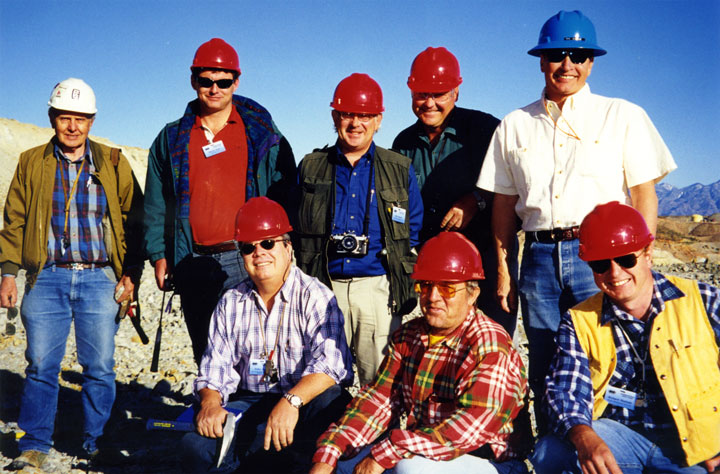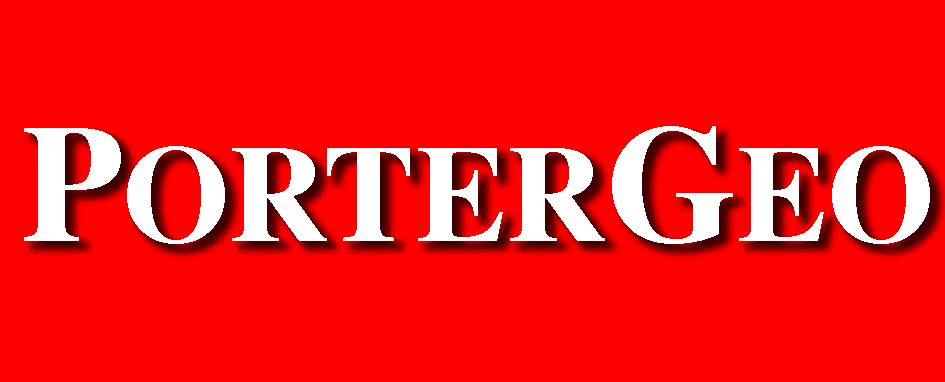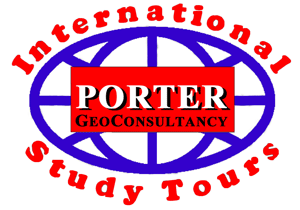| |||||||||||
| |||||||||||
| |||||||||||
|
Image: Members of the North American Module group with Spencer Titley (left).
 The AMF Cordillera '98 International Study Tour
The AMF Cordillera '98 International Study TourBy Mike Porter
From their vantage point beside the gravel road linking the El Indio and Tambo gold mines, the twelve geologists on the AMF's Cordillera '98 Study Tour had a magnificent view.
They were at an altitude of over 4000 m. In the thin, cool air, remnant snow patches clung to the sides of the mountains, softening the bright colours of the immense alteration zone covering tens of square kilometres around them. There was yellow to bright orange quartz-illite alteration, with extensive dark green and red weathering chlorite zones, and patches of white alunite, while pale green outlined the steam heated alunite of the system centres. To the east, thick snow mantled the ragged 6330 m high strato-volcano Las Tortolas which dominated the skyline, straddling the Argentine border with Chile along the backbone of the central Andes. The road stretched ahead, a scar on the flank of the barren, scree covered hillside. Clouds of dust, expanding over the valley below, pointed back like arrow heads to the distant moving dots on the road that were trucks. The road led down the valley to the collection of prefabricated buildings that were the Tambo mine offices. Beyond was the multi-coloured, rounded Cerro Elefante on whose slopes were the Wendy and Kimberley open pits of the Tambo gold mine complex. Back up the road, over the ridge to the north behind, lay the fabulous El Indio gold-copper mine with its bonanza grade quartz-gold and massive sulphide enargite-pyrite veins. Here a series of small open pits and adits leading into the altered hillsides marked the lodes. This was Thursday March 19, the fourth day of the Australian Mineral Foundation's Cordillera '98 International Study Tour. The subject of the tour was the "Porphyry Related Copper & Gold Deposits in the Cordillera of the Americas". The tour group included geologists with all levels of experience, up to exploration managers. They had come together in Santiago, Chile, on the evening of the preceding Sunday, March 15, from Africa, Australasia, Southeast Asia, southern Asia, and four countries in South America. By its end in Vancouver, Canada, on Wednesday April 8, the tour would take in fifteen major porphyry related gold and/or copper deposits in the cordillera of both South and North America. These included some of the greatest mines in the world. The tour took the participants to some remote and magnificent locations, spread over 11 000 km of the Cordillera, in four countries, and on two continents. It brought together a group of professionals from around the world to travel together and exchange experience and perspectives from their varying backgrounds. Although rewarding, the itinerary was compact, and as demanding as any other work they had done. It presented a unique and exciting opportunity for the professional advancement of the participants, tinged with a certain sense of adventure. Two Separate Modules The tour comprised two separate modules, the first of eleven days visiting seven porphyry related copper-gold and copper deposits in South America. This module commenced with a one day seminar in Santiago, Chile, also attended by fifty geologists from the local industry. It ended at Tucuman in western Argentina. The second module of ten days commenced in Tucson, Arizona in the United States on Monday March 30 with a one day workshop presented by Professor Spencer Titley of the University of Arizona, Tucson. This was followed by visits to five porphyry copper mines in Arizona and one copper-gold deposit in Utah, before proceeding to Vancouver, Canada. The module continued with a workshop at the University of British Columbia arranged and led by Professor John Thompson. It was concluded with two mines in central British Columbia. Some of the participants took both modules, while others just attended one. The Ore Deposits The ore deposits visited are some of the greatest in the world. They included the rich El Indio-Tambo gold-copper and gold only mines in Chile, the Alumbrera copper-gold deposit in Argentina, the enormous Bingham Canyon copper-gold-molybdenum orebody in Utah, western USA and the alkalic copper-gold bodies of Afton-Ajax in British Columbia, Canada. In addition, the great copper mines of Los Bronces, El Teniente, Chuquicamata, El Abra and Escondida, all in Chile, were part of the South American module. In North America, Mission, Sierrita, San Manuel, Ray and Silver Bell, were also visited in Arizona, USA, and Highland Valley in British Columbia. All of these are copper or copper-molybdenum deposits. Virtually all of the visits were excellent, and both the group and the AMF are deeply indebted to the mine geologists, too numerous to list here, for their cooperation and expertise shared, and to management for allowing us on site. Each visit comprised a briefing on the regional and local setting, as well as the geology, mineralisation and alteration of the orebody, exploration and resource evaluation, discussion on reserves, production and costs, a visit to the mine to study the orebody, and at some, additional core inspection. This collection of ore deposits was selected to illustrate the diversity of the great porphyry related orebodies, from their tectonic setting to their form and mineralogy. They included hypogene and supergene orebodies, wall rock and intrusive hosted mineralisation, disseminated and stockwork ore, breccia hosted deposits, oxide orebodies, chalcocite blankets, those with important enargite over prints, skarns, high sulphidation mineralisation, calc-alkalic and alkalic related deposits, some of the highest grade large orebodies, and the lowest grade profitable porphyry mine in operation. The selection allowed an appreciation of the variability of such deposits and the possibilities that must be considered when evaluating properties. The Seminar and Workshops Seminars or workshops were run in each of the main regions, namely South America, the US and Canada. The aim of these was to give an overview of the regional geology and metallogeny of each, and to provide a context to the ore deposits that were visited. In addition, important deposits that were precluded from the tour by time limitations, were also described. In Santiago the seminar took the form of a morning of presentations by Chilean experts, followed by talks from AMF tour participants on porphyry related deposits elsewhere in the world during the afternoon. The morning program commenced with Dr Constantino Mpodozos, Deputy Director of Geology, Servicio Nacional de Geologia y Mineria, (SERNAGEOMIN - the Chilean Geological Survey) who gave an extremely knowledgable and well presented overview of the "Tectonics, Geology and Metallogeny of the Porphyry Belt in the Central Andes of Chile, Argentina and Peru". Next, Paula Cornejo, also of SERNAGEOMIN outlined the conclusions from exciting new regional work in "The Geology of the El Salvador Porphyry Copper Deposit", followed by Richard Leveille, Chief Geologist South America for Phelps Dodge Exploration who gave a concise and entertaining description of "The Candelaria Copper Deposit, Chile", Tomás Vila, Chief Project Geologist, Codelco Chile who spoke from his extensive experience on "The Geology and Gold Deposits of the Maricunga Belt, Chile", and finally "Andean Exploration and Mining Costs" by Colin C Brooks, a Santiago based exploration consultant with a long and varied international experience. In the US a one day workshop was presented in Tucson, Arizona, by Professor Spencer Titley of the University of Arizona, Tucson. Professor Titley has an incomparable knowledge of the porphyry copper deposits of the south-western US in particular, and an extensive experience of similar deposits around the world. He gave an extremely informative, considered, but also entertaining workshop, based on his experience, which is backed by sound and diligent research. It was a privilege to have had his input. In Canada there was another one day workshop at the Mineral Deposit Research Unit (MDRU) of the University of British Columbia in Vancouver. This dealt with the porphyry copper and gold deposits of the Canadian Cordillera, and into Alaska. It was organised and led by Professor John Thompson with Dr Jim Lang and Professor Jim Mortensen. This was another excellent and informative day where the tour group benefited form the detailed, but wide experience of this trio of experts. Expert Consultants Throughout the South American module, and the south-western US segment of the North American module the participants had the benefit of expert consultants travelling with the group to give an overview, to answer questions and to interpret where required. For the first few mines in Chile, Sergio Barassi, a local consultant with more than twenty years experience in the region took this role. In the latter part of the module he was replaced by Colin Brooks, a Santiago based, Australian consultant with nearly ten years in the Andes, preceded by a career in porphyry deposits around the world. The contribution of each was appreciated by all on the tour. In Arizona, the group was accompanied by Professor Titley whose presence enhanced the value of the tour enormously. Organisation The tour was designed for maximum impact in the minimum time, in recognition of the value of the time of key industry staff. It was also split into the two separate modules, to allow participants to select the section in which they were most interested. Alternatively companies could expose different staff members to particular areas and deposits. The itinerary, while very concentrated and compact, had essential rest days to avoid fatigue and saturation. All of the planning, costing and tedious organisational detail of the tour were carried out by the AMF. This included all of the travel, meeting venues, accommodation, early breakfasts, and the myriad associated minutia, as well as the mine visits, seminars, workshops, etc.. All the participants had to do was get to the starting point with their field and travel gear, and to read the preparatory literature assembled by the AMF. This literature had been delivered before hand, along with a travel pack which included a sturdy haversack, the detailed itinerary, a geological summary, and other useful items. This preparation by the AMF permitted costs to be kept to a minimum, while removing all of the hassle and allowing the participants to focus on the main goal - some of the greatest porphyry related copper and gold deposits in the world. Return to TOP
Porter GeoConsultancy Home
| More on This Tour
| Other Tours
| About AMF
T M (Mike) Porter of Porter GeoConsultancy Pty Ltd. | |||||||||||











